March 2025

.webp)
Principal Consultant

Reviewed By
The nanomedicine market size is anticipated to grow from USD 265.88 billion in 2025 to USD 632.09 billion by 2034, with a compound annual growth rate (CAGR) of 10.1% during the forecast period from 2025 to 2034.
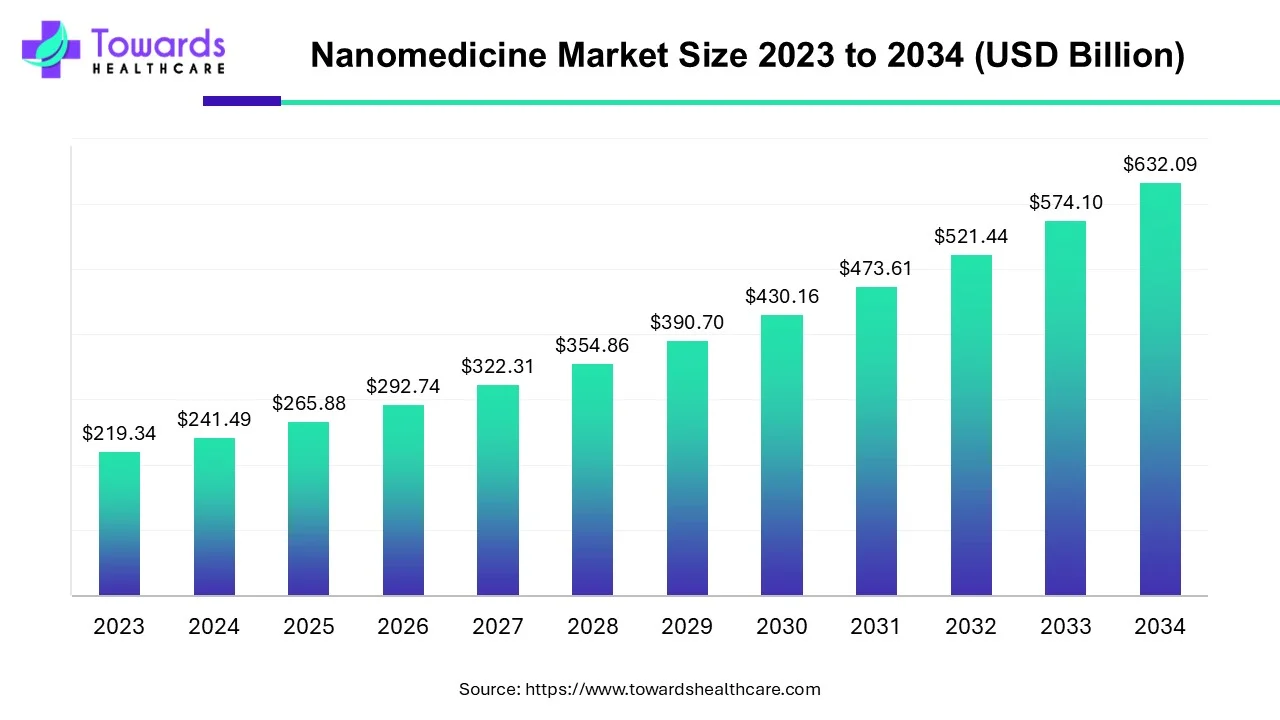
According to recent data, around 100+ nanomedicines have been commercially marketed, with almost 550+ nanomedicines under clinical trials.
Nanomedicine involves creating and utilizing tiny structures or devices, typically between 1 and 100 nanometers in size, for medical purposes such as diagnosis and treatment. These nanoscale objects or tools, including nano-robots, skin patches, or other nanostructured materials, leverage their unique properties to achieve specific medical effects.
In medicine, nanomedicine holds promise for better drug delivery systems, more accurate imaging techniques, and even tiny devices that can target and treat diseases directly at the cellular level. Electronics enables the development of smaller and faster devices, leading to better computers, smartphones, and other gadgets.
Nanomedicine also has applications in energy, where it can improve the efficiency of solar panels and batteries and environmental protection, with nanomaterials being used to clean up pollutants. Nanomedicine has the potential to revolutionize many aspects of our lives, from healthcare and electronics to energy and the environment, making it a crucial area of research and innovation.
Nanomedicine is increasingly used to treat a wide range of diseases due to its ability to target specific cells or tissues precisely. In cancer treatment, nanomedicine delivers chemotherapy drugs directly to cancer cells, reducing side effects and improving effectiveness. It's also used in imaging techniques like MRI and CT scans to detect tumors early.
Additionally, nanomedicine is being explored for treating neurological disorders such as Alzheimer's and Parkinson's by delivering drugs across the blood-brain barrier and targeting diseased cells. In infectious diseases like HIV/AIDS and tuberculosis, nanomedicine can enhance drug delivery and improve the efficacy of antiviral or antibiotic medications. Furthermore, nanomedicine is being investigated for treating cardiovascular diseases, diabetes, and autoimmune disorders by developing targeted drug delivery systems and implants that regulate blood sugar levels or modulate immune responses.
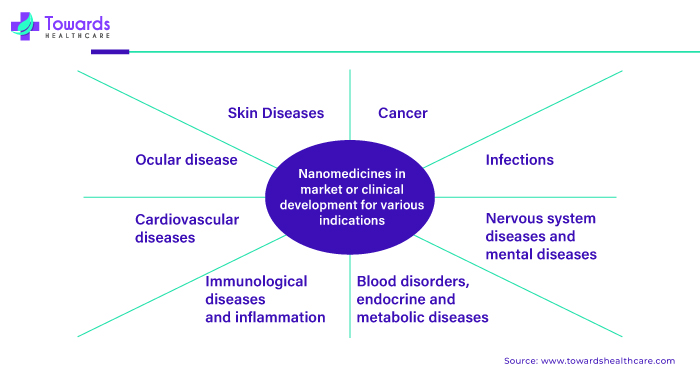
Nanomedicine holds great promise in revolutionizing the treatment of various diseases by providing more effective, targeted, and less invasive therapies, potentially improving patient outcomes and quality of life.
In 2022, there were about 1.92 million new cancer cases in the United States, and around 609,360 people died from cancer. Globally, this adds up to 9.6 million lives lost. Because cancer is becoming more common, we need new and better treatments. Nanomedicine is one promising way to fight cancer. It works by delivering treatments directly to cancer cells, which can make them more effective and cause fewer side effects. As more people get cancer around the world, scientists are seeing how nanomedicine could change the way we treat it. By using minimal materials and methods, researchers hope to improve cancer treatments and ease the disease's burden on society.
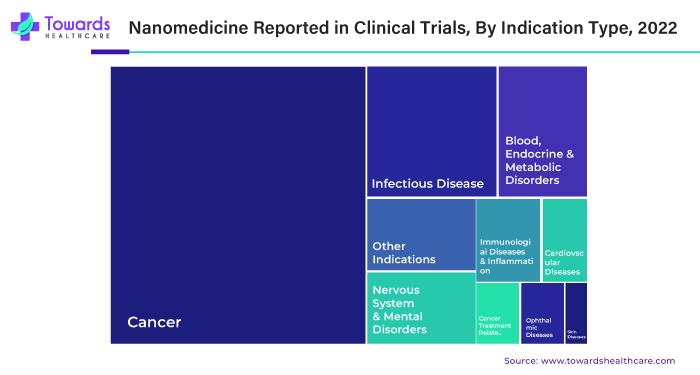
The rising number of individuals with cancer has led to significant growth in the nanomedicine market. This is because nanomedicine has some cool ways to help treat cancer. It helps deliver cancer drugs to the cancer cells so they work better and have fewer side effects. It improves how we see cancer using fancy imaging techniques like MRI and CT scans. This helps doctors find cancer early and treat it sooner.
Biomarker detection using nanomedicine is a fancy way of saying that tiny devices and sensors can find signs of cancer in our body fluids, like blood or urine. These signs, called biomarkers indicate whether cancer is present. These nanomedicine-based devices are super sensitive and accurate to spot even tiny amounts of these biomarkers. This helps doctors find cancer early when it's easier to treat and has a better chance of being cured.
Not only can these nanodevices detect cancer, but they can also keep an eye on how the disease is changing over time. This helps doctors track treatment progress and see if it's working well. Plus, by predicting how cancer might respond to different treatments, these nanomedicine-based tools can help personalize treatment plans for each patient. Biomarker detection using nanomedicine is a powerful tool for early cancer detection, monitoring disease progression, and guiding treatment decisions, all of which can improve outcomes for cancer patients.
Nanomedicine lets us make personalized treatments for each person's unique cancer. That means better results and fewer problems from treatment. It helps develop new cancer therapies like heat and light therapy and boosts the body's immune system to fight cancer. Nanomedicine can spot tiny signs of cancer in our body fluids, which helps catch it early and track how it's doing during treatment. So, because more people have cancer, there's a more significant need for these intelligent nanomedicine solutions to help diagnose, treat, and keep an eye on cancer, which is making the nanomedicine market grow.
Alzheimer's disease ranked as the sixth most common cause of death in the United States, and it dropped to seventh place in both 2020 and 2021. Neurological disorders like Alzheimer's disease are becoming more common, and nanomedicine offers promising ways to manage them. In Alzheimer's, for example, the brain gets clogged with clumps of proteins, leading to memory loss and cognitive decline. Nanomedicine can help by delivering drugs directly to these protein clumps, breaking them apart and slowing down the progression of the disease.
For instance,
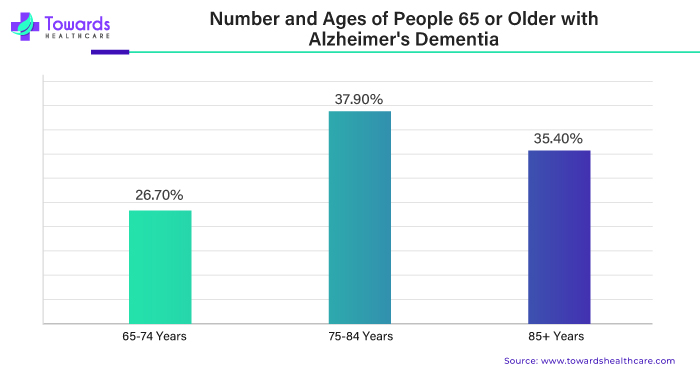
Additionally, nanoparticles can carry drugs across the blood-brain barrier, a protective layer around the brain that usually prevents medications from getting in. This allows for more effective treatment of neurological disorders.
Nanomedicine also enables the development of advanced imaging techniques to detect brain changes associated with neurological diseases early, allowing for timely intervention and treatment. Nanomaterials can create implants or devices that stimulate or regulate brain activity, relieving symptoms and improving the quality of life for patients with neurological disorders.
Furthermore, researchers are exploring using nanotechnology in regenerative medicine to repair damaged nerve cells and promote brain tissue regeneration. By harnessing the unique properties of nanomaterials, scientists are optimistic about the potential of nanotechnology to revolutionize the management of neurological disorders like Alzheimer's, offering hope for improved outcomes and quality of life for patients and their families.
Continuous improvements in making tiny things, studying them, and simulating their behavior are pushing nanotechnology forward and making the market grow. Nanofabrication techniques are methods for building small structures, like using special machines to create tiny devices or materials. Characterization tools help us understand what these little things are made of and how they work by analyzing their properties. Simulation software allows scientists to predict how nanomaterials will behave under different conditions without physically testing them.
For instance,
All these advancements are opening up new possibilities for nanomedicine, making creating innovative products and solutions easier. For example, better nanofabrication techniques allow us to make smaller, more precise devices, while improved characterization tools help us understand how nanomaterials interact with living cells or the environment. This helps researchers develop new nanotechnology-based products for various industries, from electronics and healthcare to energy and environmental sustainability. As a result, the nanotechnology market is growing as more companies invest in developing and commercializing these advanced technologies.
Getting approval for nanomedicine products can be tricky because nanoparticles behave differently than regular medicines. This makes it hard for regulators to determine their safety and effectiveness. To make things easier, we need to set up standard ways to test nanomedicine and transparent rules for how they should be regulated. This would help speed up the approval process and make it easier for these products to enter the market. Without these guidelines, it's tough for companies to get their nanomedicine products approved, which slows progress and makes it harder for patients to access these innovative treatments. Setting up clear rules and testing methods for nanomedicine is essential for getting these products out to those needing them.
| Nanosystem Type | Product Name | Active Ingredient(s) | Company | Indication(s) |
| Liposome | Myocet | Doxorubicin hydrochloride and an anthracycline cytotoxic agent | Teva Pharmaceutical Industries Ltd. | Metastatic breast cancer |
| Liposome | Onivyde | Irinotecan | Merrimack Pharmaceuticals | Metastatic pancreatic cancer |
| Nanoemulsion | Restasis | Cyclosporine | Allergan | Chronic dry eye |
| Micelle | Apealea | Paclitaxel | Oasmia Pharmaceutical AB | Ovarian cancer, peritoneal cancer, fallopian tube cancer |
| Hafnium oxide nanoparticles | Hensify | Hafnium oxide | Nanobiotix | Locally advanced squamous cell carcinoma |
North America, including the United States, Canada, and Mexico, plays a significant role in nanomedicine. In the United States, many research institutions and companies work on nanomedicine. Major pharmaceutical companies invest much in nanotechnology for medicines, diagnostics, and treatments. The FDA makes sure nanomedicine products are safe and work well. Canada also does a lot of nanomedicine research. Universities, government, and companies work together on new ideas. Canadian companies focus on using nanotechnology to deliver drugs and make better medical images. Rules in Canada make sure nanomedicine is developed and used responsibly. The North American nanomedicine market is growing because of solid funding, rules, and healthcare. More people have long-term illnesses, so there's a more significant need for new treatments. Better technology, like new ways to deliver drugs and diagnose diseases, is also helping. When academics, businesses, and government work together, it improves nanomedicine and helps it grow in North America.
Countries like China, Japan, India, and South Korea are big players in nanomedicine in the Asia-Pacific region.
For instance,
This conference aimed to share scientific advancements, industry developments, technical progress, and emerging challenges within the field of nanotechnology. They have many research centers and companies developing new nanomedicine products. Governments support these efforts with funding and initiatives. With growing healthcare needs and investments, the region is seeing rapid advancements in nanotechnology for medicine. Collaboration between countries is also helping to drive innovation and improve healthcare options.
The nanomedicine market is competitive, driven by innovation, research efforts, and market demand. Big pharma, startups, and research institutions vie to develop new nanomedicines, focusing on safety, efficacy, and manufacturing. Regulatory standards shape the landscape, favoring companies that navigate them well. Partnerships and mergers bolster positions, aiding in technology access and market expansion. It's a dynamic arena marked by innovation, regulatory compliance, and collaboration, all aimed at tackling healthcare needs with advanced nanotechnology solutions.
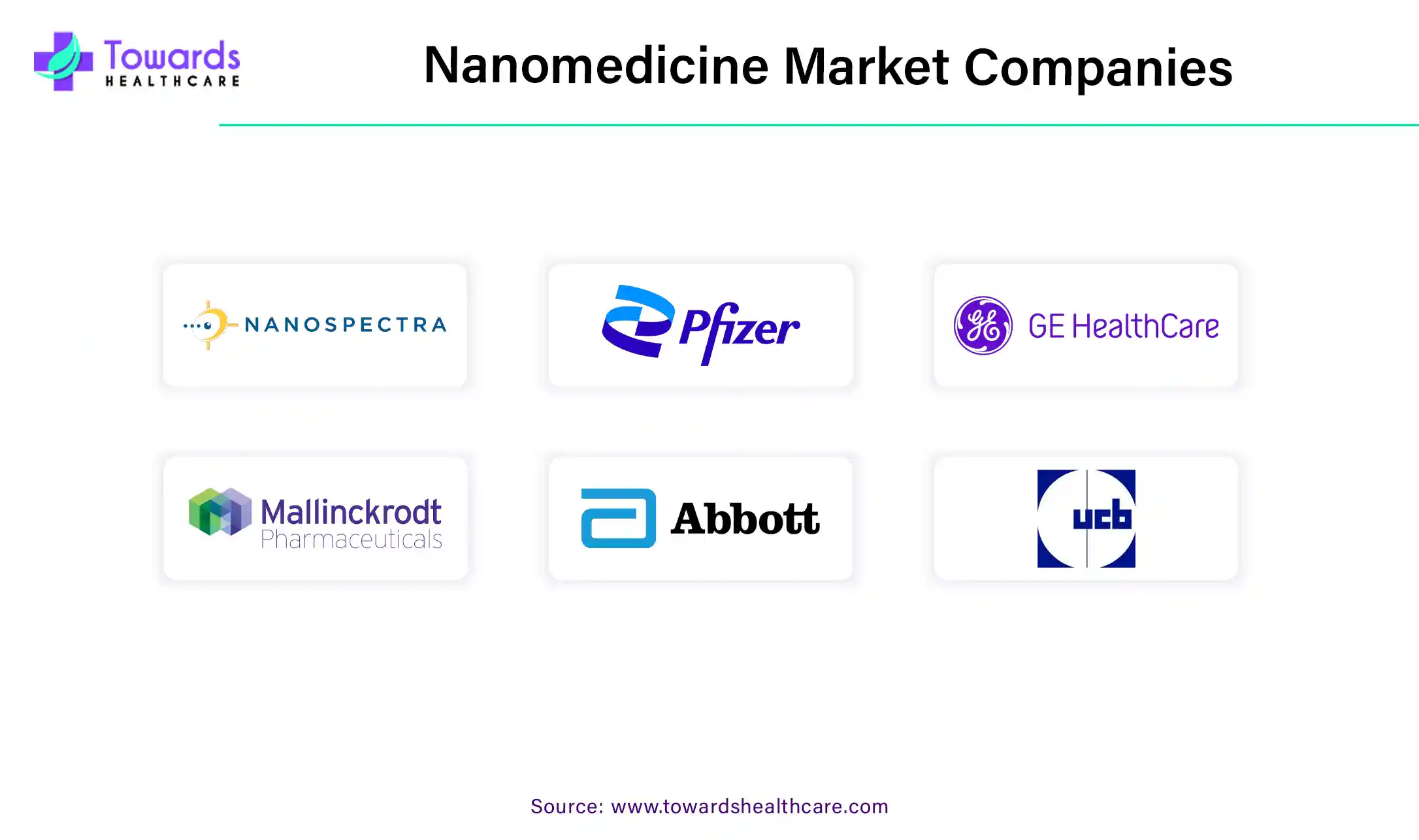
By Application
By Indication
By Molecule Type
By Geography
March 2025
March 2025
March 2025
March 2025